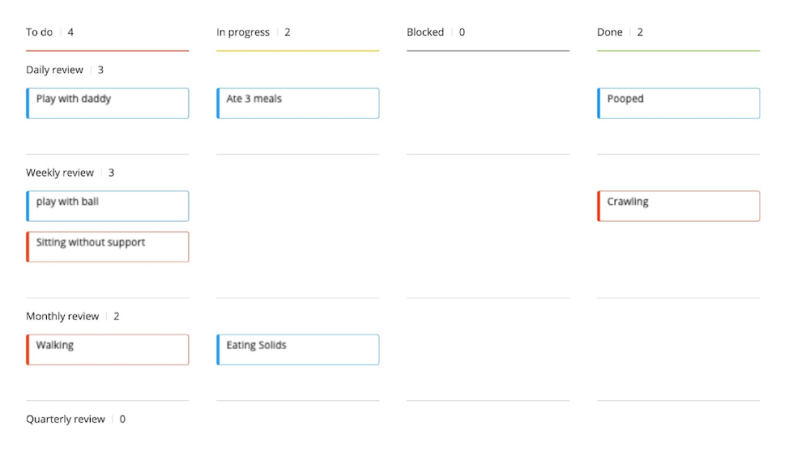In parts one and two of this series, we covered how to understand your baby customer, frameworks for identifying solutions to needs, prioritization, and story mapping. Today, we will focus on execution and defining your MVP, being an agile parent, tracking progress, and customer feedback.
What Is a Minimum Viable Setup?
Defining Your MVP ... or MVS
When daydreaming of parenthood, soon-to-be parents fantasize about a perfectly set up home, the baby playing happily in a decorated room, and all is well in the universe. However, this ideal scenario is more of a dream than what happens in practice. Parents often find that their child doesn’t play with the toys they’ve bought or that the baby gadget that promised to solve their problems didn’t work. I call this phenomenon the “parent-baby needs gap.” Rather than anticipating issues that may never exist, parents should start small and solve problems as they arise.
Similar to how we create MVPs for software, parents need to define their MVS — Minimum Viable Setup — and iterate on their solution as the baby develops and their needs change. This approach is particularly true for baby rooms, toys, and transportation.
For instance, a baby room shouldn’t be designed for a one-year-old when you come home from the hospital. Just focus on essentials: a good changing station, a comfortable sleep setup, blackout curtains, and three to five developmental toys (or objects from around the house). Everything else can wait until your baby reaches the next developmental stage. Don’t stress out over painting the walls, buying baby furniture, or picking up the latest baby IoT gear; that’s all noise for now. Focus on what matters.
Being an Agile Parent
As most new parents know, things seldom go as planned with little ones. You may have a game plan for the day, only to find that things got crazy and didn’t play out as you had thought. However, I have found that my agile/scrum training has been helpful as a parent and allowed me to make quick pivots throughout the day. Here are a couple of useful tips on how to quickly pivot:
Agile Planning for Parenthood
- Have a backup plan.
- Have a backup plan for the backup plan.
- Have a backup plan for the backup plan for the backup plan.
- When all else fails...hand off to mom.
Joking aside, the bottom line with being an agile parent is not to be locked into your plan (or roadmap). Instead, have fallback plans when your experiments fail (just as we do with user testing), and don’t be afraid to pivot when you discover new information.
Tracking Progress
As product managers (PMs), we love to track KPIs for our products and try to push them to the next level. This is an area where I think we have to be very careful as parents and not treat our children as products. As I have stated in my previous articles, every child is different and develops in different ways and at different paces. Life isn’t a race, and we shouldn’t treat it that way.
The CDC publishes developmental milestones that you should be aware of and use as a reference to track some of the fundamental developmental milestones for your child.
In addition to milestones, I’ve found tracking my child's activities beneficial, which helps me stay organized as a parent. For this, I like to use a kanban board taped to my refrigerator.

Kanban allows me to track daily, weekly, and monthly activities and ensure nothing slips through the cracks. I organize my board into To Do, In Progress, Blocked, and Done columns, and my wife and I move tasks along the board as we complete them. The process may seem a little OCD to some folks, but it’s a great way to stay in sync with your partner.
Customer (Baby) Feedback
PMs measure customer behavior and talk to customers to get feedback on their products. Although measuring a baby’s behavior indirectly can be difficult, you should definitely communicate with your customer and check in on how you are doing.
As noted in part one, one of the most difficult challenges as a parent is the communication barrier with your new baby. Though they might not verbally communicate when they’re very young, they’re trying to tell you all kinds of things in their own way. So you just have to learn their language.
Babies communicate from birth through crying and eye contact, along with simple sounds and gestures. Be sure to get very close to their faces as their eyesight is not very good and communicate with them through eye contact and a warm facial expression. In later developmental stages, babies communicate with sounds and gestures. Pay attention to subtle gestures and noises your baby may make as you address their five key needs. They may move their legs and arms in excitement or distress and later move on to gestures like pointing.

Their communication skills change rapidly over time, and they will eventually start making sounds that mimic you and try to form basic words (although they will not know what they mean).
How often should you collect feedback from your little customer? A daily check-in from day one is beneficial to help their cognitive development. You can even make baby cooing sounds and mimic them while having conversations in your imaginary baby language — I’ve had many long jibberish conversations with my son that he found utterly fascinating.
Studies have shown that children who are read to for at least 20 minutes a day are exposed to almost 2 million words annually. Another study shows that kids who read one short book a day enter their first school years hearing nearly 300,000 more words than those whose parents did not read for them. If a parent reads more than one book, the number increases again; five books per day increases their vocabulary exposure by 1.4 million words! Daily reading significantly impacts your child’s vocabulary as an adult and sets them up for a good start in life.
Wrapping It Up
I hope you’ve found this series about parenting like a product manager exciting and that I’ve convinced you that PMs have an excellent skill set to nail parenthood. The key takeaways from this series are:
- Don’t aim to get parenting right from the beginning. Instead, start small, define your MVS, and keep iterating as your child moves on to the next phase.
- Prioritize what’s most important to your child right now. Don’t try to solve problems that do not exist yet.
- Things change quickly; what works today might now work tomorrow. Be an agile parent, have many backup plans, experiment and try new things with your child, and go with your solution until it doesn’t work (which might be sooner than you think)
- Don’t feel judged. Your little customer does not crave perfection. More than anything, they just want to spend time with you and feel loved.
Please share your thoughts on social media about parenting as a professional and what skills you have learned from your profession that have helped you become a better parent. You can find me on LinkedIn to further connect on the topic.





